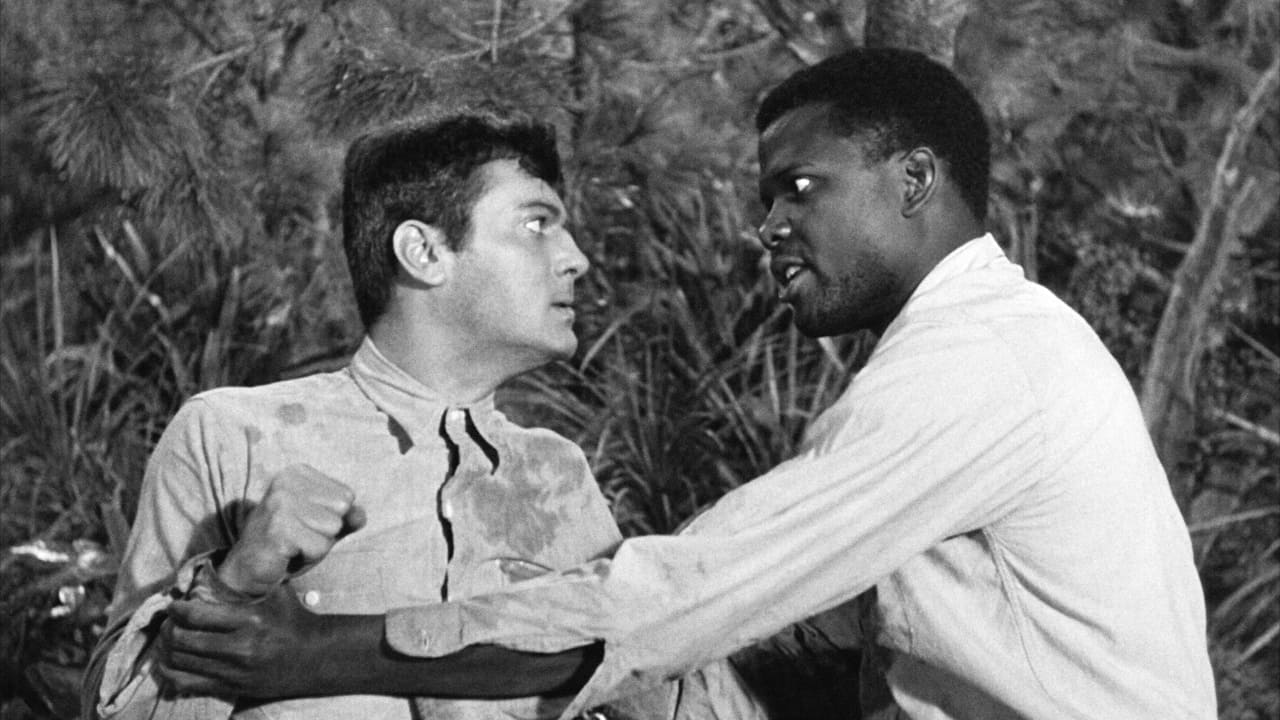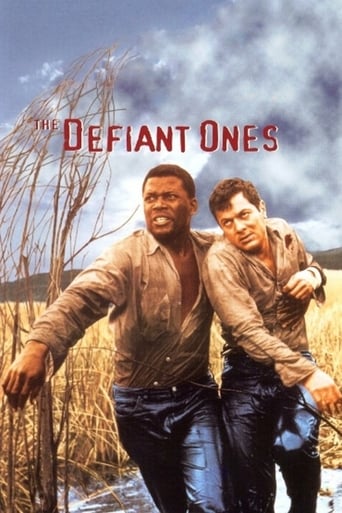

Given this was a Stanley Kramer film, I expected a much heavier handed social message movie. Instead, "The Defiant Ones" is spare and lean, and it eschews righteous speeches about the evils of bigotry for commentary that is more potent because it is allowed to emerge organically from the situations and the way the characters respond to them. I'm thinking of how ahead of its time this film was when it was released in 1958. Almost 10 years later "In the Heat of the Night" would galvanize audiences with the image of Sidney Poitier slapping a white man; in this film, not only does a black man punch and spit on white men, but a white and black man share a cigarette and snuggle for warmth. This film was mentioned in the James Baldwin documentary "I Am Not Your Negro," and Baldwin held it to task for what he believed was its cop-out ending that only existed in order to make whites feel better about the racial divide. I get where Baldwin is coming from, but I would challenge him on his point. Like it or not, "The Defiant Ones" wasn't made for a black audience. It was made for a white audience, a vast majority of whom came into the movie with preconceived notions about black people based on limited experience. Would Baldwin have rather the movie reinforced stereotypes about blacks or offered its white audiences an alternative to challenge their perspective? Sidney Poitier and Tony Curtis give terrific performances, as do Theodore Bikel, as the humanistic sheriff tracking them down, and Cara Williams, as a single woman who gives the men shelter and emerges as perhaps the most vile representative of a kind of white racism rampant then and still rampant now. All four were nominated for Oscars, and the film also received nominations for Best Picture, Best Director (Stanley Kramer), Best Original Story and Screenplay (which it won), Best B&W Cinematography (which it also won), and Best Film Editing. That this film lost Best Picture in the same year that "Gigi" won should tell you all you need to know about white indifference to racial turmoil.Grade: A
... View MoreBefore anything else I wish to stipulate here, that this writing is non-partisan one and has nothing to do with any form of racism, communism or whatsoever deviant behavior - cf., "Defiant Ones" (1958) and also less prominent remake with Carl Weathers and Robert Urich in 1986. If Stanley Kramer dared to produce this movie in 1958 and Tony Curtis (White Male Caucasian) participate in principal leading role, subsequently I don't see reason to swell 60 years later when about half of Hollywood actors are colored and Film Industry in the making depend on this people. The reason I took this small undertaking is to try (if possible) to dispel the myth of African American Culture, its boundaries and genesis, and its role in interpreting current history of USA and all English speaking people on this planet Earth. It's a fair coin, I think both Blacks and Whites should understand me."The Defiant Ones" (1958), gave Sidney Poitier his first Academy Award nomination as Best Actor. Five years later, he won the Oscar for "Lilies of the Field" (1963), the first African American to win for a leading role. His roles in "Guess Who's Coming to Dinner" (1967) and "To Sir, with Love" (1967) were for their time landmarks in the breaking down of social barriers between African Americans and Whites.I took the paragraph above as citation from IMDb. Certainly its a good place here to mention some other Black American film stars that I have remembered vividly in the 1960s, 1970s and 1980s - Harry Belafonte, Jim Brown, Fred Williamson, Yaphet Kotto, James Earl Jones, Richard Pryor (died of dementia in 2005), Eddie Murphy, etc. Those were people that single-handedly could perform and produce a good Movie for the Big Audience. There are other names that I have missed maybe, but as a rule good Films in those times were the ones that were remembered. In the 1990s already African Americans in Hollywood Films became a cliché, there were so many nominations and deserved medleys that I am not in position right now to make an appreciation.I will go further a little bit. I am a self-conscious citizen and read all kind of literature (on equal opportunity). I have books in my library on Black Racism and White Racism, the way it started in the American Southwest from the years of 1860 and on. Mass Organizations such as Ku Klux Clan appeared as reaction on the loosing Confederate side. As counter reaction the free Black Americans left their cluster Southern States and migrated internally East and West all over USA. They started to study Culturally and Physically in High Schools and Universities. They interbreed freely in marriages with Whites and casted a singular alloy of racial unity - namely, Mulattos (if you can distinguish them physically) are as good as Blond or Brunette Whites. So what's the case here? Why are we still reading pieces of literature like "We Charge Genocide" (1951) by Civil Rights Congress on pages of Wikipaedia. It's high time for reconciliation ...
... View MoreThe Defiant Ones has a concept too simple to fail and its executed accordingly. What makes it special is the well written banter between the two anti-heroes supported through Tony Curtis and Sidney Poitier's great performances as they bond and fight. The struggle between them is fascinating, particularly in how the physical obstacles in front of them are written. This paralleled with the subplot of the authorities in their pursuit with their inter conflict makes the cat-and-mouse plot entertaining to watch. The Oscar-winning cinematography also helps bring a cinematic spark to some scenes to lift it from the occasional John Ford-esque stage sets. While it starts to slow down in pace in the third act, its beautiful full circle seals the deal. Great classic.8/10
... View MoreThe time of extreme racism has long gone, but this chained-together white and black convicts' escaping adventure simply hasn't waned much for its in-your-face impact of genuine thrill and sympathy, director Stanley Kramer's (from SHIP OF FOOLS 1965, 6/10) third feature, gathering Curtis and Poitier as the "impossible pair", the film would successfully pave the way for Poitier and Kramer's prospective Oscar-winner echelon and afford Curtis a splendid career-turn with his only Oscar nomination. One could easily be aware of the shooting condition since clearly Curtis and Poitier have taken their toll in their harsh fugitive surroundings, wrestling with the precipitate torrent, the mud pit under the pouring rain, a perilous marsh and finally a running train. But those are only default set pieces to sustain the film in its narrating procedures, a sharp and sound script does remind me how slowly the civilisation progress we have achieved since only 50 years ago, the world could be utterly colour-sensitive. Curtis and Poitier's two handers are meticulously orchestrated, but among the supporting group, Cara Williams and Theodore Bikel also obtained two Oscar nominations. The former partook in the latter half and induced the most poignant confrontation for Curtis' character, choosing between freedom (even love) and the brotherhood with a black prisoner (mercifully, the finale reciprocates with the same dilemma for Poitier). Meanwhile, Williams exhibits a dooming desperation out of the unsatisfied woman without being sidelined as a cipher in the plot. Bikel, is the Sheriff with a kind heart, whose gritty and congenial persona has re- established the integrity of the police force. Last but not the least, Poitier's a cappella rendition of W.C. Handy's "Long Gone (From Bowlin' Green)" has been repeated three times in the film, the beginning, the middle section (where they are caught by the village people) and the ending, precisely elevating the film's brio and set a great example of how a theme song could generate such an ineffable passion and evocation into a film's texture. ps: the film got two Oscars among its 9 nominations, BEST CINEMATOGRAPHY BLACK & WHITE and BEST ORIGINAL SCREENPLAY.
... View More